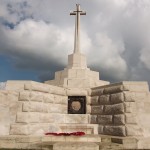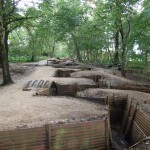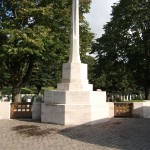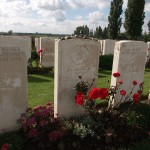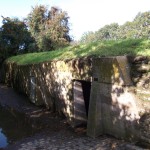The importance of the Western Front in our history is attested to by a visit to this area forming part of the National Curriculum. For many people it is personal: few families did not lose a father, son or brother in the conflict.
There are few places that can move a visitor so much as these battlefields: including apparently cynical teenagers. Silverblue Tours is experienced in operating battlefield tours in the two regions and we understand that the raison d’être of the trip is only partly to learn ‘the facts’. Even more important is that the reality of life in the trenches comes alive. This is achieved through perfect planning and handpicked guides.
Ypres
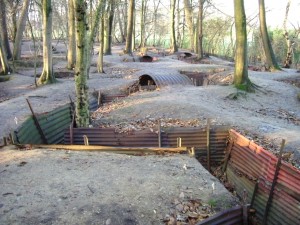
“Wipers” was more or less razed to the ground during the war but has been reconstructed beautifully. A “must” is attending the Last Post ceremony at the Menin Gate that has taken place nightly at 8pm every single day since WW1 with the exception of the period of German occupation during WW2.
We liaise with the tour leader regarding the itinerary but normally recommend the following:
Tyne Cot cemetery, which is the largest Commonwealth war cemetery in the world in terms of burials.
Hill 62 (aka Sanctuary Wood) Trench Museum in Zillebeke. Here original British trenches have been preserved as they were found after the war. In the 1980s a tunnel was discovered. The museum collection contains equipment removed from the battlefield in the vicinity and many photographs, as well as a rare collection of three dimensional photo images in viewing boxes.
the German cemetery (Soldatenfriedhof) at Langemarck, which contains some 44,292 burials (concentrated from other burial sites). Even from a distance you can sense that the atmosphere at this cemetery is quite different to that at the Allied cemeteries: it is dominated by large, heavy, shady oak trees and is walled as opposed to lightly fenced.
Entrance is along a tunnel of sorts which features several monitors depicting the burying of the verlorene Kameraden amongst other themes. The chiming of the church bell in one of them evokes a horror film… arriving at the entrance, you see a long, low, dark red granite building.
The cemetery is darkened by the towering trees…at the rear is a bronze sculpture of four mourning figures by Prof Emil Krieger. It is a powerful and haunting work of art. The figures have next to no features and the silhouette effect is heightened by the fact that one is looking at them with the sky behind them.
Essex Farm cemetery & First Aid Dressing Station is probably the most visited and most famous site in the Ypres Salient. It was named after a small cottage that stood beside the Boesinge road at the entrance to the canal access track.
In the grounds of Essex Farm Cemetery are concrete dugouts that were used between 1915 and 1917 as a dressing station.
There is also a cemetery on site, including the poignant tombstone:
VALENTINE JOE STRUDWICK
Rifleman
5750
8th Bn., Rifle Brigade
who died on
Friday, 14th January 1916. Age 15.
In Flanders Field is the name of the wonderful museum in Ieper which has all kinds of captivating effects and an excellent bookshop!

The Somme
Duckboards, mud and horror. The Battle of the Somme resonates down through the years almost a century after the 5 months in 1916 when the French, British and German armies registered over a million casualties. Even today rusted weapons and ammunition, and unfortunately human remains, continue to come out of the earth often through ploughing.
A glance at the Somme battlefields indicates that Albert is located to the centre. We use this small town as a base and as with Ypres, while the itinerary is completely flexible depending on the group’s own preference, we would normally include the following:
Just a few minutes drive out of Albert (at La Boiselle) is the 100 metre wide and 30 metre deep crater known as Lochnagar, created in literally the first moments of the Battle of the Somme by a series of vast explosions. A ceremony continues to be held at 7.28 am on July 1st every year to commemorate (attracting an increasing number of Australians – mindful that the British Army was actually the British Empire Army). The story surrounding this incident is a fascinating one and will be related in full by the guide.
Thiepval is home to the Commonwealth War Graves Commission’s largest memorial to the dead who have no known grave. This spectacular construction was unveiled by the Prince of Wales in 1932 and bears the names of more than 72,000 officers and men of the United Kingdom and South African forces who died in WW1 in the Somme sector before 20 March 1918.
The Newfoundland Memorial Park at Beaumont Hamel commemorates the Royal Newfoundland Regiment which, along with several British battalions, attacked this area as part of the 1st of July 1916 Somme offensive and suffered appalling losses. The land was originally bought in 1921 by Newfoundland and officially opened by Earl Haig in 1925. It has a good visitor centre, a splendid statue of the proud Newfoundlanders’ emblem animal, and most interesting of all a very well-preserved trench system that you will find still has stories to tell.
The Somme 1916 Museum is a perfect place to get a flavour of life in the trenches. It is set within a WW2 air-raid shelter 230 metres long, with sound and lighting effects as well as various scenes peopled by wax dummies and original artefacts and maps. The interpretative boards are excellent.
Poppies School Hotel in Albert
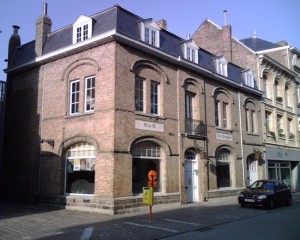
The Poppies School Hotel is located in the centre of Albert and is close to many facilities such as a local pool, lake and wetlands area and the excellent Somme 1916 Museum.
The school hotel itself has 3 floors which can each be closed off to the other floors allowing 3 groups to be accommodated totally separately from each other. The student rooms sleep 5 children each and are clean and bright. The staff rooms are located at each end of the corridor to allow for excellent control of the children.
The games rooms are large and bright with table football and pool on offer as well as a music system. There is also a small lounge area with fridge on each floor for the staff to relax.
Contact us to find out more about our battlefield group tours.

